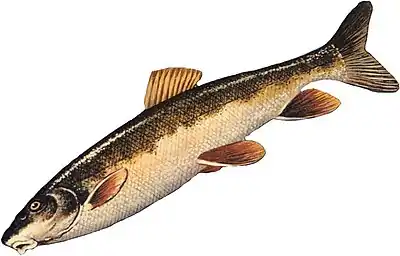Longnose sucker
The longnose sucker (Catostomus catostomus) is a species of cypriniform freshwater fish in the family Catostomidae. It is native to North America from the northern United States to the top of the continent. It is also found in Russia in rivers of eastern Siberia, and thus one of only two species of sucker native to Asia (the other is the Chinese Myxocyprinus asiaticus).
| Longnose sucker | |
|---|---|
 | |
 | |
| Scientific classification | |
| Kingdom: | Animalia |
| Phylum: | Chordata |
| Class: | Actinopterygii |
| Order: | Cypriniformes |
| Family: | Catostomidae |
| Genus: | Catostomus |
| Species: | C. catostomus |
| Binomial name | |
| Catostomus catostomus J. R. Forster, 1773 | |
| Subspecies | |
| Synonyms | |
| |
Description
The body of the longnose sucker is long and round with dark olive or grey sides and top and a light underside. They are up to 64 cm (25 in) in total length and weigh up to 3.3 kg (7.3 lb).[3]
Longnose suckers are easily confused with white suckers (Catostomus commersoni), which appear very similar. However, longnose suckers can be distinguished by their comparatively finer scales.[4]
Ecology
The longnose sucker inhabits cold, clear waters. It is a bottom-feeding fish, eating aquatic plants, algae, and small invertebrates. They are preyed upon by larger predatory fish, such as bass, walleye, trout, northern pike, muskellunge and burbot.
Relationship with humans
They are fished for game and food and also used as bait to catch the larger predators. The IGFA world record sits at 6 lbs 9 oz taken from the St. Joseph River in Michigan.[5]
References
- NatureServe. 2014. Catostomus catostomus. The IUCN Red List of Threatened Species 2014: e.T62192A3109321. Retrieved 7 May 2018
- Bonnichsen, Bill; Breckenridge, Roy M. (1982). Cenozoic Geology of Idaho. Idaho Department of Lands, Bureau of Mines and Geology.
- Froese, Rainer and Pauly, Daniel, eds. (2019). "Catostomus catostomus" in FishBase. May 2019 version.
- "White Sucker, Catostomus commersoni and Longnose Sucker, Catostomus catostomus". Michigan Department of Natural Resources. State of Michigan. Retrieved 23 January 2016.
- "Sucker, Longnose". igfa.org. International Game Fish Association. Retrieved 17 May 2019.
External links
- Earl J.S. Rook (1999) Catostomus catostomus Longnose Sucker A private species profile page.
- University of Wisconsin Sea Grant Fish of the Great Lakes fact sheet
